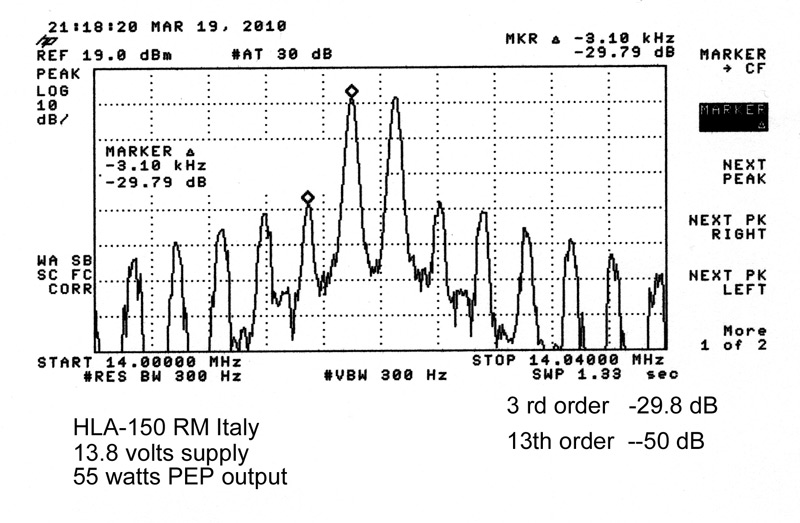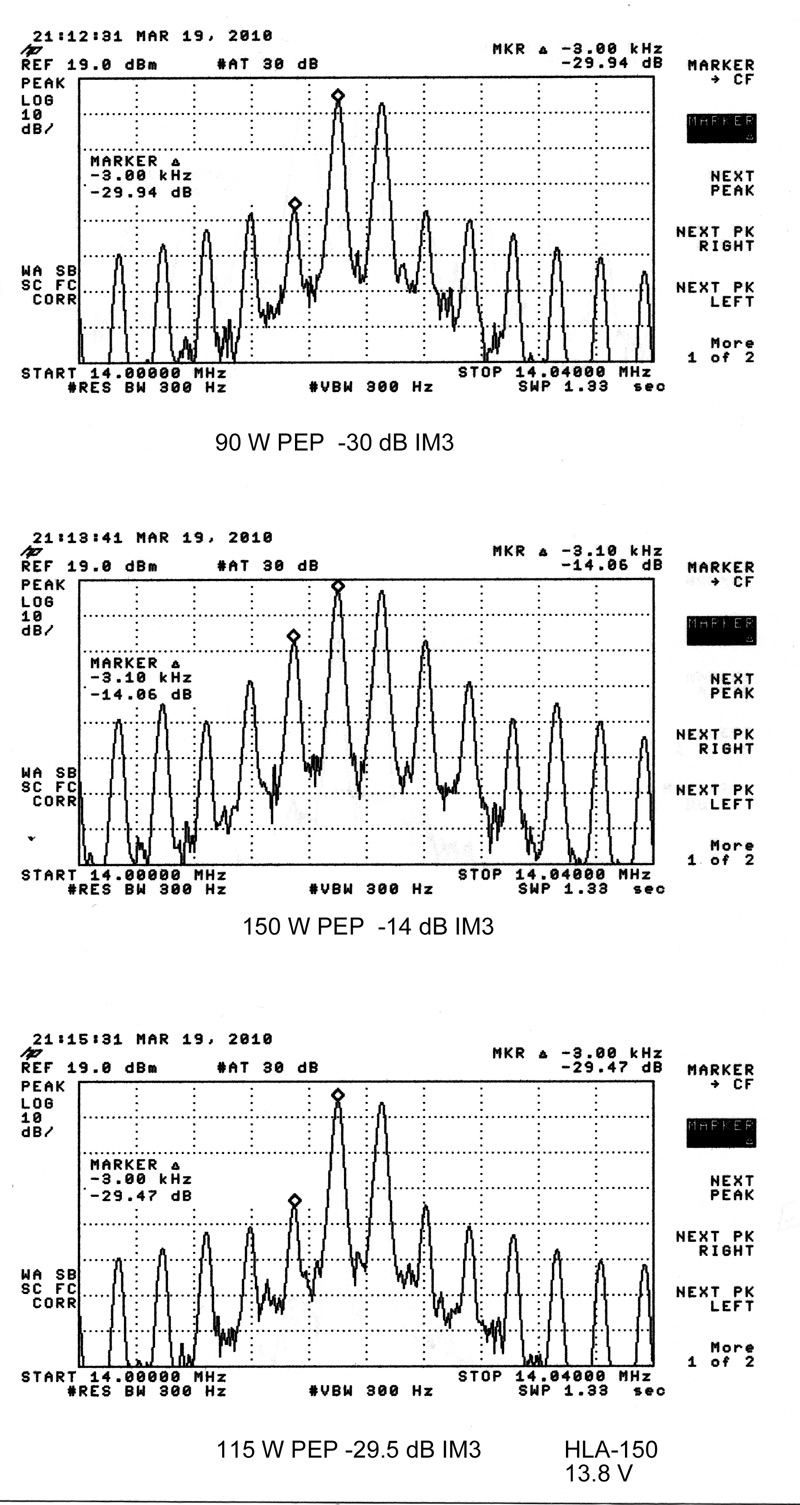Some people claim an HLA-150 is a very clean amplifier. One odd thing is the transistors are specified for about 70 watts maximum output per transistor, yet RM Italy calls the HLA-150 a "300 watt PEP" amplifier. I was very fortunate in that a nice fellow loaned me his HLA-150 for testing. While I am very grateful, I will not mention his name or call publicly. If anyone has a similar popular amplifier I'd be happy to test it as time permits.
I found the saturated power, into absolute limits, as 155 watts PEP with a 13.8 volt 50-ampere power supply. Gain compression began at about 125 watts PEP.
I tested the amplifier using a well-regulated 50 ampere 13.8 volt power supply. I used two variable power generators through 6 dB high power attenuators into a 50 ohm combiner. The output of the combiner went into a 3 dB pad into the amplifier. This is necessary to ensure the generators see 50 ohms, and have good isolation between each other.
To verify the generators are working correctly I added another 3 dB pad, and when adjusted to the same amplifier power level IMD measurements did not change more than normal variations with time.
Power was measured on a Bird digital power meter. It was last calibrated two years ago with a 1% standard.
Here are the actual IM tests.

The test generator is two 0 to 100 watt signal sources into a combiner.
IMD was into composite noise.
It is important to have a very clean exciter to not affect the actual amplifier distortion. In this case the generator is very clean. The main problem is composite noise.

IMD at 55 watts output. The extended or higher-order IM products are of particular note. They go on forever it seems.
This amplifier, like most, has a "sweet spot". The sweet spot is above 30-40 watts and below 110-120 watts.

90W PEP IM3 is -29.94 dB one tone of two equal tones. This is the method used commercially for years by Eimac and others.
Add -6 dB to get ARRL type measurements, which started to be popular when the Collins KWM-380 came out. This method makes things look a little better by making numbers 6 dB higher.
The RM Italy distortion is close to that of nearly all HF transceivers, except for troubling higher order products. Products shown are 3rd, 5th, 7th, 9th, 11th, and 13th. They actually go on forever, it seems.
The 13th order product is only 17 db down from the 3rd order product.
150W PEP.
3rd order very poor -14 dB one tine of two equal tones (-20 PEP).
While shamelessly marketed as a 300-watt PEP amplifier, this clearly is not even a 150-watt PEP amplifier. At 150 watts PEP intermodulation is terrible, much like a class C amplifier. This is to be expected because the amplifier shows significant gain compression starting at 125 watts PEP. This makes sense, because the transistor specifications indicate the same thing.
Lower-order distortion at 115 watts PEP is acceptable, it is about the same as any typical radio. The high-order products are not acceptable.
Summary of IMD and Power Tests
300 watts PEP: It is not a 300-watt PEP amplifier, not even close. That is an absolute lie.
150 watts PEP: It is not a 150-watt PEP SSB amplifier. The IMD is far too high at 150 watts.
120 watts PEP: It looks better at this power. Except for the wide bandwidth high-order IM products, the HLA-150 is comparable to most HF radios in distortion at a power output of 115-120 watts PEP. The high-order IMD is significantly worse than the worse case IM for a typical 100-watt transceiver when the HLA-150 is at 120 watts PEP. Above 120 watts things fall apart very fast.
90 watts PEP: The HLA-150 is a 90-watt PEP amplifier at best, and if operated that way will be acceptable for many uses. It is not as good as it could be for the very wide bandwidth distortion at higher power, but it is comparable to worse-case IMD for a common radio like the FT1000MP when it is at 90-watts PEP output.
I was in a bit of an debate with someone who insisted he could evaluate this amplifier on PSK31 and other modes. ( I of course disagreed with his test method.) There are several problems associated with using an IMD meter provided in digi-mode software. If we look at the tests above we see why a PSK system might indicate acceptable results at 50-100 watts. This is because PSK and other digital modes are not concerned with high-order IMD products so long as they are less than the low-order products. The higher order products will often fall outside the receiver filter bandwidth, and not be registered on the display. High-order products are, for all purposes, ignored by the system. Performance was also tested right in the "sweet spot" of the HLA-150.
Harmonics
The HL150 amplifier has exceptionally good harmonic suppression on most bands. The low-pass filters work well. It is an acceptable amplifier when operated at 90 watts PEP output or less.